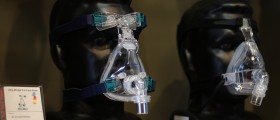
Montelukast is a type of medication primarily used to elevate the symptoms of asthma and to relieve signs of seasonal allergies. The medication is in most cases administered orally. Asthmatic and allergic reactions occur when adverse chemicals are created by cells, discharged, and attached to other cells. The process of connecting to the other cells induces inflammation. Also, montelukast binds to the cysteninyl leukotriene receptor in the respiratory system and hinders the effects of adverse cell binding. As a result, the bronchial tubes are unblocked and inflammation is lessened. It should be noted that there are rarely any interactions between montelukast and other asthma medications, but the drug is seldom used for acute asthma problems. There are other medications used for the same purpose, such as Zileuton, but patients often better tolerate the side effects of montelukast. The medication was developed in Montreal, hence the Mont in its name. The brand name for the medication is Singulair while The Food and Drug Association approved the medication in 1998. Numerous clinical trials demonstrated its effects and it has been established that montelukast can be used in treatment of infants as young as 6 months of age. In addition, there are generic versions of the medication available for use and both generic and brand types require prescriptions.
Effects Of MontelukastThe primary purpose of the medication is to ease the breathing process, reduce chest tightness, coughing, and wheezing that are induced by asthma. Also, montelukast is used in prevention of breathing difficulties in individuals who suffer from asthma when engaged in physical activities. Lastly, those who experience seasonal allergies can also reduce discomfort and go on with daily activities when taking montelukast.
How To Use MontelukastMontelukast is employed in treatment of various medical conditions including acute bronchospasms, asthma, and allergy induced rhinitis. As is the case with treatment of many respiratory illnesses, montelukast is used in combination with other medications, mostly inhalators based on corticosteroids. The inhalators are the first line of treatment and additional medications are introduced only if the former do not yield positive results. Further, anyone who is contemplating taking montelukast should be informed about the side effects that arise after prolonged usage. One of the most prominent negative effects on the physical health includes gastrointestinal problems. Individuals who take the medication can expect to bleed for longer periods of time in case they cut themselves or anything of similar nature. Sleep problems are also prominent side effects. When it comes to taking the medication, two types of tablets are available. The one kind is to be swallowed and it contains 10 mg of the substance. The other type is chewable and the dosage is reduced in half. If the tablets that need to be swallowed are chewed or broken down into half the absorption of the medication is much faster and in turn the patient may experience poisoning. The chewable tablets are given to children while adults use the 10 mg ones. Montelukast should be taken in the evening before or after dinner. It does not interfere with food in any way. Once the patient starts to use montelukast the first effects should be noticed within the first few days. More substantial relief of symptoms appears after about 2 weeks. Consequently, acute allergy or asthma attacks would not be cured by montelukast. The package should not be refrigerated. Rather, a dark spot and room temperature will keep it safe. When it comes to drug interactions, in most cases montelukast does not interfere, but when taken with Phenobarbital or rifampin its effects may be heightened and the dosage therefore should be reduced.
When To Be CautiousThere hasn’t been enough research to show the effects of montelukast on pregnant women and their fetuses. In the case of animals if the drug is administered orally it will pass through the placenta and into the fetus. The effects on the fetus in humans are still unknown. For this reason most medical care professionals will prescribe zafirlukast during pregnancy provided that it produces more desired effects than the possible negative ones. When it comes to nursing and taking montelukast, similar problems are present. In studies conducted on animals it has been shown that the medication appears in milk. In the case of humans it is still unknown whether the drug is present in the milk and what effects if any would that have on the developing baby. Aside from the already mentioned side effects, patients may experience dizziness and headaches. It is unclear whether the ability to operating motor vehicles or heavy machinery is hindered but caution is always advised. Some abdominal pain may be felt, and many users have complained of a sore throat. In relatively rare cases individuals may be faced with nosebleeds. Not everyone experiences the side effects. It is estimated that anywhere between 1 in 7 and 1 in 50 users will suffer from some of the negative effects of montelukast.






_f_280x120.jpg)










Your thoughts on this
Loading...